Last Updated on April 25, 2023
The world is obsessed with cute animals and the Pomeranian is nothing if not cute. With their huge fluffy coats and teeny tiny paws, they melt hearts just by looking like a tumbleweed on their legs.
White Pomeranian are so magical, they look like they are made up of the stuff of fairytales. Mystical and enchanting, learn all there is to know about the elusive and highly popular White Pom-Pom!

Quick Navigation
- 1 What is a White Pomeranian?
- 2 What Does a White Pomeranian Look Like?
- 3 How Big Does a White Pomeranian Dog Get?
- 4 There are 2 Types of White Pomeranians
- 5 Temperament: Are White Pomeranians Good Family Dogs?
- 6 How to Take Care of Your White Fluffy Pomeranian
- 7 White Pomeranian Health and Hereditary Conditions
- 8 Price: How much is a White Pomeranian puppy?
- 9 White Pomeranian vs Japanese Spitz
- 10 Is a White Pomeranian Right For Me?
- 11 Further reading: Other White breeds
What is a White Pomeranian?
White is the original color of the breed, cropping up as far back as 1892.
They lost their reign when orange reared its head in championships and started bringing home titles, and white was lost in the sea of breeders who tried so hard to create more orange champions.
Unfortunately, introducing and breeding for other colors soon overwhelmed the white gene.
Colored genes are often more dominant than the white recessive gene. This is why the White Pomeranian has become so rare in recent years.
When the breed was being bred in Pomerania, an area now known as Poland and Germany, the breed did not have as many color selections as it now did.
These relatives of the German Spitz were much bigger than they are now, too. Weighing in at 30 lbs (13.6 kg) or more, they were small to medium-sized sled dogs.
Thanks to Queen Victoria’s penchant for these small dogs, they gained popularity throughout England and America.
Her favorite pooch was called Marco, an Orange Pomeranian who bagged home countless titles. It was then that colored Poms gained popularity and the White Pommies were almost pushed into oblivion.
Today, they can be found in a wide variety of colors. They can be black and white, merle, or blue! White Poms are making a comeback.
Largely toted around by celebrities in the United States, their coat color adds another layer of majesty to the breed.
What Does a White Pomeranian Look Like?
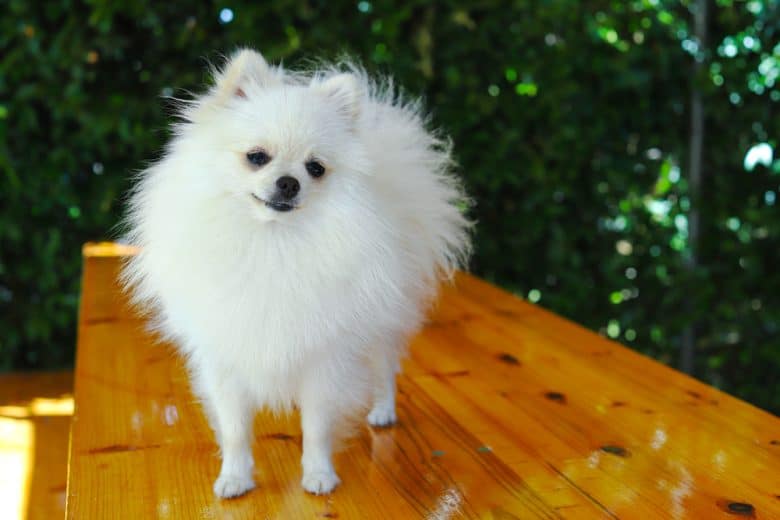
Pomeranians are a toy dog breed that has a coat that can only be described as profuse. They have a ruff around their necks that make it seem like they are proud little dogs.
This spitz dog has a tail that curls in on their bodies, making it seem like a cascade of fur.
While their double coats should feature a soft undercoat and a harsh topcoat, some White Pomeranians have soft topcoats that are seen as a fault.
If you’re planning to enter your pup into a dog show, you want to watch out for this type of wrong coat. They shouldn’t have the silky smooth hair that Maltese dogs have.
These cute dogs have a v-shaped muzzle that should be half the length of their skulls. The ideal, according to the American Kennel Club, is to have a compact body shape that is almost squarish.
How Big Does a White Pomeranian Dog Get?
Poms usually grow into their adult size by the time they are 10 months old. If they are still growing by then, you probably have what is called a Throwback Pom.
These dogs can grow up to 20 lbs (9 kg)! Teacup Pomeranian puppies, on the other hand, grow up to be less than 3 lbs (1.4 kg).
The AKC breed standard states that Standard Poms should be 3 – 7 lbs (1.4 – 3.2 kg), and no taller than 14 inches (36 cm). Females can be larger than males, especially if intended for breeding.
There are 2 Types of White Pomeranians
A White Pom should have a completely white coat, without any underlying yellow or cream tones. Their eyes, noses, and paw pads should also be black. If they lack pigment, they are a Pom that suffers from albinism.
Parti Poms have the piebald coloring which is largely white with one other color. Poms with three colors including white are called Tri-Colored.
White Parti Poms with the dilute gene might have liver or blue pigmented noses and eye rims.
Some Poms marketed as White Poms are actually very light creams. Also, white dogs bred from partis are always parti, even if their markings are so faint you can’t see them.
Also read: Types of Pomeranians
Coat Color: Will White Pomeranian Puppies Stay White?
One thing that all new Pom owners should know is that Pom puppies don’t stay the same color. Many puppies that are born white can mature into Parti Poms or Cream Pomeranians.
Black puppies might turn brown or grey with age. Orange Sables are very often born dark.
To look at all the color variations of this breed and learn how their color changes, check out our post on Pomeranian colors.
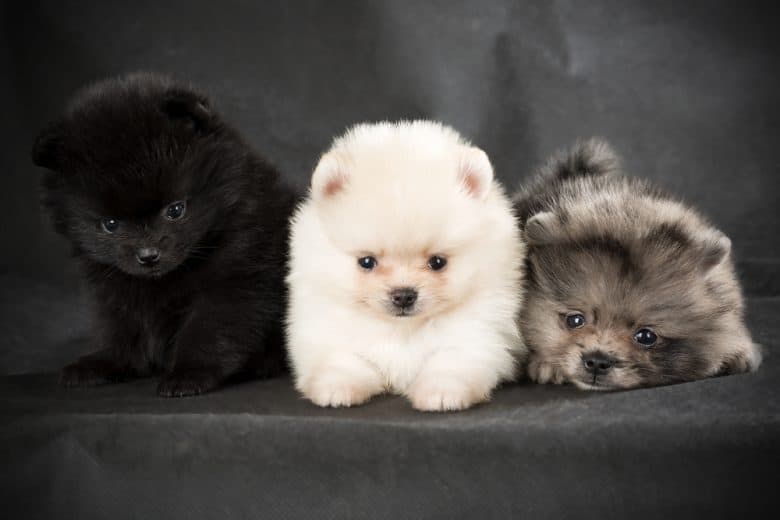
Their colors shift and change until their puppy uglies and they grow in their adult coat. This starts around the 3 – 4 week mark and lasts till they are 10 months old.
For White Poms, you won’t be able to tell whether they’ll stay white until around the 8 – 12 week mark. In any case, Pure White Pomeranians will never have any kind of darker fur.
Telltale signs that your puppy isn’t going to be a white dog will usually show up behind its ears.
Also read: Get to Know All the Colors of the Pomeranian
Temperament: Are White Pomeranians Good Family Dogs?
Dogs just want to be with their owners and Pomeranians will be your shadow. You might find yourself calling for them, only to realize that they were behind you all the while.
These lap dogs love being with their humans and can be a friend to all with proper training.
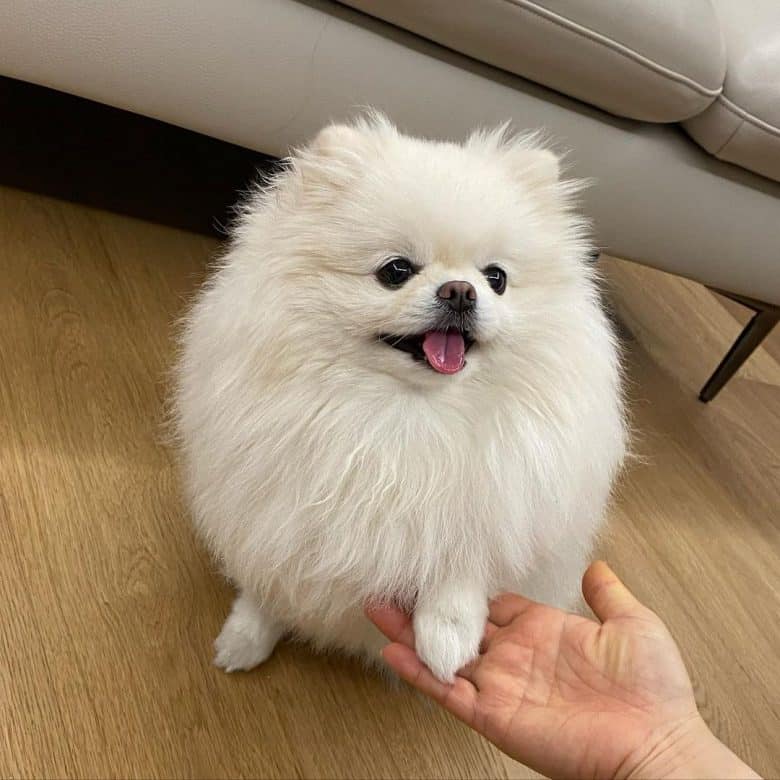
Poms are a boisterous dog breed that can be quite independent and pushy if left to their own devices. While they can be great first dogs as they aren’t hard to handle, they do need some patience and a dedicated hand.
As with many small breeds, the Pomeranian breed is known for being hard to potty train.
Due to their small size, they have small bladders and aren’t great at holding them in, so consistency is key. Crate training is also a great way to housetrain a toy group breed.
This toy breed is an amazing watchdog. However, their barking can get quite incessant. These small dogs can go on and on, which can cause even the most patient and empathetic owner to lose their minds.
Do yourself and your neighbors a favor and teach your little fluffy pooches to be quiet.
One reason that might exacerbate barking is separation anxiety. While Poms are naturally independent dogs, separation anxiety can still develop.
To prevent this, create a routine! When they learn what to expect, they should naturally calm down.
Overall, the White Pom has exactly the same temperament as any other colored Pom. They are loving, great with kids, and can get along with other animals.
You’ll notice that they bond strongly with their owners and are unfailingly loyal. However, these dogs have a tendency to develop small dog syndrome, so be sure not to spoil them.
How to Take Care of Your White Fluffy Pomeranian
Pomeranians are considered highly adaptable. They can live in hot or cold climates, provided that you offer them adequate shelter.
Their thick fur protects them against the elements and regulates their temperature, that’s why it’s crucial never to shave them. This can cause damage to their coat and their natural protection.
They are also rather clean animals with very minimal smell and no drooling. Perfect for people who can’t handle drool.
Exercising your White Pomeranian
All Poms are upbeat and happy to go for a quick 15-minute walk once or twice a day. According to popular belief, your Pom will reflect your energy level.
If you’re outgoing and active, your Pommie will be too. But don’t expect your Pom to romp around as a Golden Retriever will.
Poms might love to run around with their pawrents, you need to be careful that they don’t overheat.
Grooming: How does care for a White Pomeranian differ from the care of other Pomeranians?
White Poms are a little bit more high maintenance because it’s hard to keep that pure white coat clear of stains! They are prone to tear stains so you’ll want to clean their eyes once a day.
Many White Pomeranian owners have some kind of cleaning spray that allows them to clean specific areas without bathing the dog. Trimming the fur around the paws will keep grime off their feet too.
Baths should be avoided because too much bathing can cause their skin to dry out. It’s best to bathe them once every three weeks or more.
The good thing is that Pomeranians don’t have much smell, so you can really stretch between baths.
Overall, Pomeranian grooming is relatively pain-free. Brushing them with a steel comb twice a week will keep their coat fluffy and healthy.
Some owners love giving their Pom-Poms a makeover for easy maintenance. They can be shaped into a lion or a bear.
Just look at how cute Alvin is as a white teddy bear:
To see a full list, take a look at our Pomeranian haircuts guide.
Feeding: White Pomeranian Food Consumption
They don’t require much and usually only eat about ¼ – ½ cups of kibble a day. Don’t just get the first dog food you see on Amazon, make sure you shop around before committing to a brand.
All Pomeranians will benefit from high-quality dog food that’s specially formulated for small breeds.
This is because a big breed kibble might not have the same nutrient content that is suitable for the caloric requirements of a small dog. Also, large breed kibble is usually much bigger and hard on the Pom’s little jaws.
White Pomeranian Health and Hereditary Conditions
Poms have quite a long life expectancy and their average lifespan is 12 – 16 years.
Buying from a reputable breeder will help ensure the longevity of your dog. It can also help prevent your dog from developing any hereditary health problems.
They are considered a healthy breed overall, but they are prone to tracheal collapse, which causes an obstruction in their airways. Common symptoms include coughing or making a loud raspy noise, as well as heavy breathing.
They can also develop alopecia x which makes their skin turn black and their fur falls off. This black skin disease is not curable and doesn’t harm the dog in any way, except cosmetically.
A luxating patella is a loose kneecap that can cause excruciating pain. Other joint problems such as hip dysplasia can also appear in this breed.
Other things you want to look out for are hypothyroidism, hypoglycemia, entropion, or distichiasis.
White dogs are often associated with deafness so to put your mind at ease, you should bring your White Pom for a hearing exam.
Price: How much is a White Pomeranian puppy?
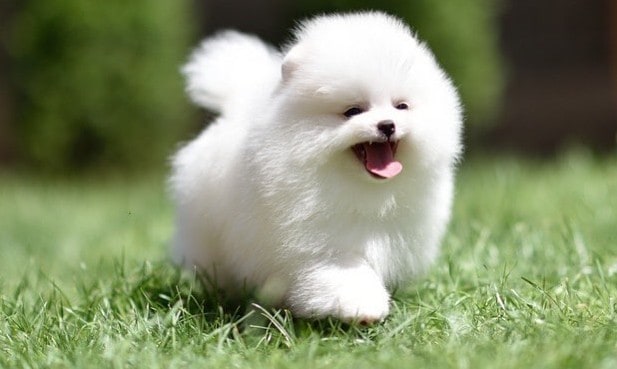
Pomeranians are not cheap because breeding them comes at a high cost. High-quality Pure White Pomeranians can cost around $500 – $5000, depending on the breeder.
Snow White Pomeranians often fetch a higher price because it’s hard to produce them.
Another factor that contributes to their price is the breeding process. Much like bulldogs, they can have difficulties giving birth naturally and might need a C-section.
After a cesarean, the mom dog will have to rest and the breeder will need to assist in keeping the puppies alive and well. All of this takes time, money, and lots of effort.
Also read: How Much Do Pomeranians Cost?
White Pomeranian breeders
If you’re dead set on getting an Ice White Pomeranian, make sure you do your research because Pomeranians have a tendency to darken in color. White Pomeranians can develop lemon or cream coloring as they mature.
A reputable breeder will not try to con you into buying a puppy that isn’t guaranteed to be white because they have a reputation to protect.
Furthermore, they will be more invested in placing their puppy in a good home than making a quick buck.
With a little bit of research, you’ll be able to find a responsible breeder off the AKC’s marketplace or by word of mouth:
- Yuma Poms (Somerton, AZ) – yumapoms.com
- Real Puppies of Beverly Hills – www.realpuppiesofbeverlyhills.com
White Pomeranian rescue and adoption
White Poms might not be as common as Orange Poms, but that doesn’t mean you can’t check out your local shelters to see if there’s any in need of a loving home.
Dogs get abandoned for all kinds of reasons, from life circumstances to a poorly behaved pooch.
You can talk to the shelter owners or fosterers if they have a dog that suits you best. They’ll be able to tell you about their medical history, background and personality.
There aren’t any color-specific shelters to date, but you can try out any of these Pomeranian rescues:
- Rescue Me Animal Network (Watkinsville, GA) – pomeranian.rescueme.org
- Recycled Poms (Dallas, TX) – recycledpoms.org
White Pomeranian vs Japanese Spitz
You might think that the White Pommie looks familiar… And you’re right. They are the spitting image of the Japanese Spitz! The difference is that Japanese Spitz’s are bigger, falling in the small-medium category.
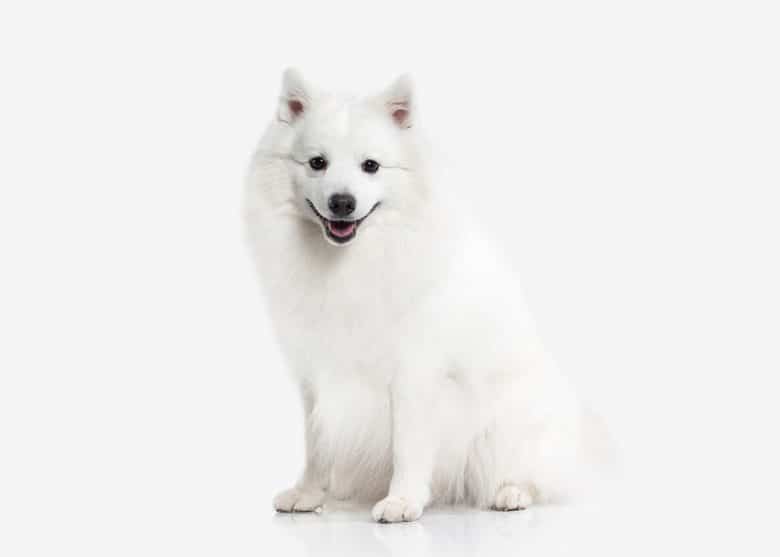
They can grow up to 11 to 20 lbs (5 to 10 kg), averaging at 15.5 lbs (7 kg). These larger dogs are also much more active than the small Pom-Pom.
They can also be more stubborn, which doesn’t make them ideal for first-time owners.
Is a White Pomeranian Right For Me?
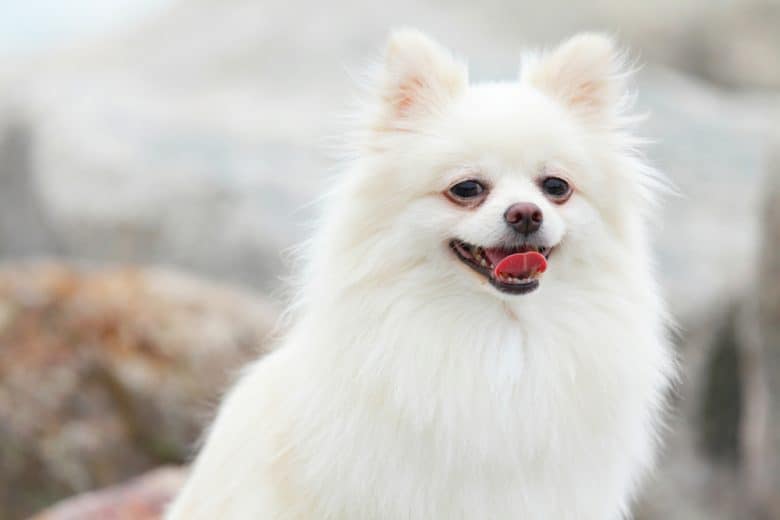
A White Pom puppy might be the cutest thing you ever see, with their beady black eyes and pristine fluffy coats, and they make a great addition to any family.
However, White Pomeranian care is not a walk in the park. It takes great care and effort to keep their ice white coats clean. Be sure you’re prepared to deal with constant care and cleaning before you bring them home.
Further reading: Other White breeds
Cess is the Head of Content Writing at K9 Web and a passionate dog care expert with over 5 years of experience in the Pet Industry. With a background in animal science, dog training, and behavior consulting, her hands-on experience and extensive knowledge make her a trusted source for dog owners.
When not writing or leading the K9 Web content team, Cess can be found volunteering at local shelters and participating in dog-related events.
